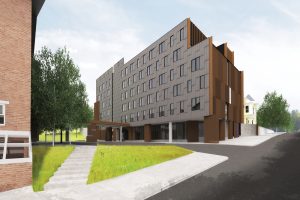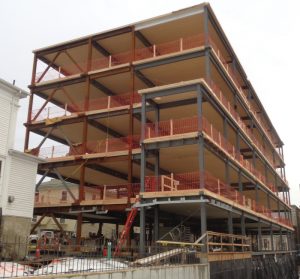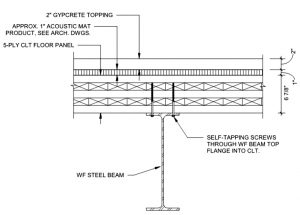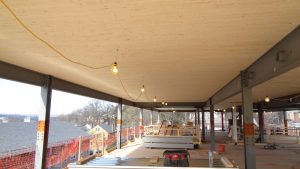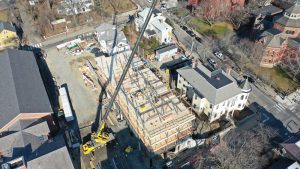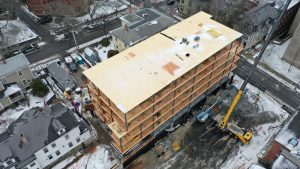Rhode Island School of Design
A new six-story student residence hall in Providence, Rhode Island, incorporates exposed cross-laminated timber (CLT) panels supported by steel framing. By using this structural system in a dormitory for the first time in New England, an Integrated Project Delivery team achieved the client’s lofty goals of beautiful design, environmental sustainability, and an aggressive construction schedule. The erector exceeded all expectations by completing the superstructure construction in under three weeks.
Doing something new required a calculated risk by everyone involved, but the system yielded unexpected benefits for the project that the team could never have imagined.
Planning for Growth
RISD (pronounced “Riz-Dee”) is among the world’s great art and design institutions. With 2,500 undergraduate and graduate students, the school has studio-based programs in fine arts, architecture, design, and art education. Perched on Providence’s historic College Hill, the school has not constructed a new residence hall in over thirty years. RISD needed more space to house a growing student population and create a better housing experience.
Seeking to expand its capacity to house first-year students and revitalize its aging residential quadrangle, RISD engaged Odeh Engineers and NADAAA architects to develop numerous master planning schemes for the site.
Faced with outdated floor plans, poor energy efficiency, and a challenging sloped site, the team brainstormed options to rehabilitate and improve the interconnectivity of the structures and create new spaces for housing, art studios, and amenities. RISD ultimately selected a scheme that would transform student life, including a new six-story, 148-bed building and significant renovations to the remaining buildings to bring them into the 21st century. The project had broad sustainability goals that resonate with RISD’s students, faculty, and programs.
Working with Shawmut Design and Construction of Providence, the team established a budget for the proposed work based on a large catalog of masonry and precast concrete plank dormitories constructed in the region. The project was called “RISD Quad.”
Answering the Call
In early 2018, RISD approved financing for the Quad but with a new challenge: was it possible to complete the detailed design, construction, and commissioning of the proposed new building in under 18 months to allow phased construction of the renovations without reducing student bed count – all within the original project budget?
To respond to this need, RISD assembled an Integrated Project Delivery (IPD) team consisting of Shawmut, NADAAA, Odeh, and other key consultants and subcontractors. The IPD team used a combination of innovative thinking and lean construction management tools to address the challenge.
IPD Enables Innovation
Teams often fail to innovate because they fear the unknown. They may not seek the best solution available, but instead the solution that offers the least risk to each party. Designers limit risk from professional liability – tried and true solutions offer the most confidence in avoiding blame for errors and omissions. Contractors want designs that they know they can build and offer the least possibility of schedule delays and subcontractor buyout risk.
However, risk comes in many forms – most importantly, the risk of building the wrong building that will hinder the client’s mission in the future, long after the designers and contractors have finished their work. When faced with the challenge of building a highly sustainable project to inspire a future generation of students, with a fixed budget and aggressive schedule, the RISD Quad team needed to turn to innovative ideas that could unleash productivity gains without compromising the client’s key goals.
A critically important aspect of IPD teams is the close collaboration between contractors and designers from the earliest phases of project planning. For the RISD Quad, this collaboration fostered innovative thinking and gave birth to a new concept: using mass timber construction combined with structural steel framing.
Choosing a New System
Cross-laminated timber (CLT) is a type of engineered wood panel that consists of dimensional lumber boards glued together in a press with structural adhesives. Available in multiple thicknesses, widths, and spans, CLT is strong, lightweight, dimensionally stable, and inherently fire-resistant. CLT members can act as walls, floors, and roofs in combination with timber or other forms of structural support, including steel.
In the last few years, CLT has emerged as a very popular structural design option for buildings in the western United States and is growing in popularity. However, very few large-scale projects have been constructed in New England. A relatively small number of material suppliers in the region, combined with the novelty of the product, can make CLT appear to cost more when compared to other structural floor systems. How then did the RISD Quad team successfully make the leap to CLT for this project?
Working in close collaboration, the IPD team first identified multiple design options for consideration, creating concept design sketches for each option suitable for comparison. Contractors, designers, and the owner then gave each option a numerical score for multiple factors, including the speed of construction, durability, sustainability, and operational flexibility. After scoring these advantages, the team compared the estimated costs of each approach. This process, a type of lean construction management tool called “choosing by advantages,” allowed the owner to assess the overall value proposition from each structural system (instead of just the first cost, which often fails to capture key benefits of a specific option).
For RISD, the options included a precast concrete plank building with steel supports and a heavy timber post and beam style structure. Ultimately, the team selected the CLT–Steel Hybrid system despite a slightly higher cost premium (approximately 10%) because of the following perceived advantages:
- Sustainability. CLT is made from sapling lumber that can be harvested sustainably. Timber framing also sequesters carbon from the atmosphere, since trees consume carbon dioxide as part of the photosynthesis process.
- Aesthetics. CLT panels have an inherent fire rating, due to the charring effect recognized in the International Building Code (IBC), and can be exposed without fireproofing as a ceiling. This characteristic allowed for savings in drywall for the ceilings and a highly desirable aesthetic look for the building interiors. The architect and owner felt that the exposed wood interiors also echoed themes of sustainability that students experience in RISD’s curriculum.
- Speed. Most importantly, the CLT–Steel hybrid system provided a schedule advantage. Working closely with the selected fabricator, Nordic Structures of Quebec, the team optimized the layout of CLT panels to minimize the erection time. Nordic manufactured the 5-ply panels in 8-foot-wide x 50-foot-long spans. Thus, each slab spans the entire width of the building. Due to the lightweight nature of the material, the erector could use a smaller crane compared to precast concrete slabs. Furthermore, since the contractor could field core most of the plumbing penetrations in the panels without reinforcement, the fabricator could significantly reduce shop drawing preparation and review time when compared to a precast concrete plank system.
Optimizing the Design
The composition of the floor structure consisted of 5-ply Grade E1 CLT floor panels measuring 6 7⁄8 inches thick. An architectural grade finish was provided on the underside of the CLT panels, which would be exposed as the ceiling in the living areas. Special mitigation measures were required atop the CLT panels to achieve the desired vibration and acoustic characteristics of the floor structure. Directly above the CLT, the floor assembly consisted of a combination of acoustic isolation mats totaling approximately 1 inch in thickness, a 2-inch-thick layer of self-leveling poured gypsum concrete, and finally a vinyl composition tile. This floor assembly met the owner- and code-required STC rating equal to 50. Additionally, the added mass provided by the 2-inch-thick topping of gypsum concrete enhanced the vibration characteristics of the floor system.
The triple span continuous CLT floor panels are supported by steel wide flange beams at the exterior of the building and a line of framing down either side of the central corridor. The steel wide flange beams were fabricated with staggered holes in the top flange to allow fastening of the steel to CLT from the underside of the CLT panels. In coordination with the CLT fabricator, the team chose to use MyTicon self-tapping wood screws to fasten the steel framing to the CLT panels. The use of the MyTicon screws was another decision that went on to provide schedule savings to the team. Screws up to ½-inch-diameter could be drilled into the CLT without the need for pre-drilling as compared to a similar diameter lag screw, requiring each screw to be pre-drilled. Thus, the team realized a much faster detailing time frame on site.
Unexpected Benefits
HB Welding, the steel and CLT erector, had recently completed another residential building in Providence using precast concrete plank and steel framing. After comparing the two projects, the erector realized some unexpected benefits, including:
- Safety. For field modifications and coring, CLT can be cut using a chainsaw. Compared to concrete slabs, the wood panels can generally be cut from the top on one side, and do not induce silica dust hazards.
- Logistics. Due to their lightweight (approximately 19 psf, compared to 75-80 psf for precast concrete planks), multiple CLT panels can be shipped on one truck. This resulted in fewer trucks on the site and less required staging area.
- Camber. The CLT for the RISD Quad project shipped with almost no camber and the erector could easily align the horizontal joints between adjacent panels using a nailed spline connector.
These unexpected benefits, combined with the advantages already recognized by the team to help HB Welding in conjunction with a crew of carpenters, allowed for the erection of the entire superstructure in 2.5 weeks in the middle of winter in Rhode Island. By completing the structure early, other trades could gain access to the space more rapidly and further enhance the project schedule for completion. As of this writing, the project is on track for on-time delivery in August of 2019.
Conclusions
The RISD Quad team succeeded in bringing the first hybrid CLT-Steel residence hall to life in New England by prioritizing innovation and working together to achieve a shared vision. An integrated project delivery approach allowed for close collaboration between the designers and constructors – each bringing their best ideas to the table to create a better solution than they ever thought possible. Future residence hall projects in the region, and beyond, may consider this option as a viable alternative when the speed of construction and sustainability are key considerations of the team.
For RISD, combining mass timber and steel construction exceeded the client’s goals for a sustainably designed new home for the next generation of students.■

